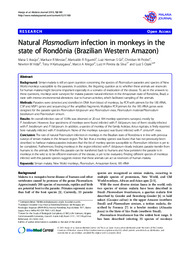Natural Plasmodium infection in monkeys in the state of Rondônia (Brazilian Western Amazon).
Natural Plasmodium infection in monkeys in the state of Rondônia (Brazilian Western Amazon).
Author(s): ARAÚJO, M. S.; MESSIAS, M. R.; FIGUEIRO, M. R.; GIL, L. H. S.; PROBST, C. M.; VIDAL, N. M.; KATSURAGAWA, T. H.; KRIEGER, M. A.; SILVA, L. H. P. da; OZAKI, L. S.
Summary: Background: Simian malaria is still an open question concerning the species of Plasmodium parasites and species of New World monkeys susceptible to the parasites. In addition, the lingering question as to whether these animals are reservoirs for human malaria might become important especially in a scenario of eradication of the disease. To aid in the answers to these questions, monkeys were surveyed for malaria parasite natural infection in the Amazonian state of Rondônia, Brazil, a state with intense environmental alterations due to human activities, which facilitated sampling of the animals. Methods: Parasites were detected and identified in DNA from blood of monkeys, by PCR with primers for the 18S rRNA, CSP and MSP1 genes and sequencing of the amplified fragments. Multiplex PCR primers for the 18S rRNA genes were designed for the parasite species Plasmodium falciparum and Plasmodium vivax, Plasmodium malariae/Plasmodium brasilianum and Plasmodium simium. Results: An overall infection rate of 10.9% was observed or 20 out 184 monkey specimens surveyed, mostly by P. brasilianum. However, four specimens of monkeys were found infected with P. falciparum, two of them doubly infected with P. brasilianum and P. falciparum. In addition, a species of monkey of the family Aotidae, Aotus nigriceps, is firstly reported here naturally infected with P. brasilianum. None of the monkeys surveyed was found infected with P. simium/P. vivax. Conclusion: The rate of natural Plasmodium infection in monkeys in the Brazilian state of Rondônia is in line with previous surveys of simian malaria in the Amazon region. The fact that a monkey species was found that had not previously been described to harbour malaria parasites indicates that the list of monkey species susceptible to Plasmodium infection is yet to be completed. Furthermore, finding monkeys in the region infected with P. falciparum clearly indicates parasite transfer from humans to the animals. Whether this parasite can be transferred back to humans and how persistent the parasite is in monkeys in the wild so to be efficient reservoirs of the disease, is yet to be evaluated. Finding different species of monkeys infected with this parasite species suggests indeed that these animals can act as reservoirs of human malaria.
Publication year: 2013
Types of publication: Journal article
Unit: Embrapa Eastern Amazon
Keywords: Floresta amazônica, Macacos, Malária simiática, Plasmodium
Observation
Some of Embrapa's publications are published as ePub files. To read them, use or download one of the following free software options to your computer or mobile device. Android: Google Play Books; IOS: iBooks; Windows and Linux: Calibre.
Access other publications
Access the Agricultural Research Database (BDPA) to consult Embrapa's full library collection and records.
Visit Embrapa Bookstore to purchase books and other publications sold by Embrapa.

